Geospatial Disaggregation of Population Data in Supporting SDG Assessments: A Case Study from Deqing County, China
Abstract
:1. Introduction
2. Materials and Methods
2.1. Study Area
2.2. Data Source and Processing
2.3. Methods
2.3.1. Determination of Residential and Nonresidential Areas
2.3.2. Establishment of Population Disaggregation Model
2.3.3. Gridded Population
3. Results and Analyses
4. Disaggregated Population Data for Assessing SDGs: Examples
4.1. Example 1: SDG Indicator 3.8.1
4.2. Example 2: SDG Indicator 4.a.1
4.3. Example 3: SDG indicator 9.1.1
5. Discussion and Conclusions
Author Contributions
Funding
Acknowledgments
Conflicts of Interest
References
- United Nations. Transforming Our World: The 2030 Agenda for Sustainable Development; United Nations: New York, NY, USA, 2015. [Google Scholar]
- Chen, J.; Ren, H.; Geng, W.; Peng, S.; Ye, F. Quantitative Measurement and Monitoring Sustainable Development Goals (SDGs) with Geospatial Information. Geomat. World 2018, 25, 1–7. [Google Scholar] [CrossRef]
- Monteiro, J.; Martins, B.; Pires, J.M. A hybrid approach for the spatial disaggregation of socio-economic indicators. Int. J. Data Sci. Anal. 2018, 5, 189–211. [Google Scholar] [CrossRef]
- Wu, J.; Wang, X.; Wang, C.; He, X.; Ye, M. The Status and Development Trend of Disaggregation of Socio-economic Data. J. Geo Inf. Sci. 2018, 20, 1252–1262. [Google Scholar] [CrossRef]
- UN World Data Forum. Hybrid Census to Generate Spatially-Disaggregated Population Estimates. Available online: https://undataforum.org/WorldDataForum/hybrid-census-to-generate-spatially-disaggregated-population-estimates/ (accessed on 22 November 2018).
- Ouma, P.O.; Maina, J.; Thuranira, P.N.; Macharia, P.M.; Alegana, V.A.; English, M.; Okiro, E.A.; Snow, R.W. Access to emergency hospital care provided by the public sector in sub-Saharan Africa in 2015: A geocoded inventory and spatial analysis. Lancet Glob. Health 2018, 6, e342–e350. [Google Scholar] [CrossRef]
- Linard, C.; Tatem, A.J. Large-scale spatial population databases in infectious disease research. Int. J. Health Geogr. 2012, 11, 7. [Google Scholar] [CrossRef]
- Tatem, A.J.; Garcia, A.J.; Snow, R.W.; Noor, A.M.; Gaughan, A.E.; Gilbert, M.; Linard, C. Millennium development health metrics: Where do Africa’s children and women of childbearing age live? Popul. Health Metr. 2013, 11, 11. [Google Scholar] [CrossRef] [PubMed]
- Tatem, A.J. Mapping the denominator: Spatial demography in the measurement of progress. Int. Health 2014, 6, 153–155. [Google Scholar] [CrossRef] [PubMed]
- Balk, D.L.; Deichmann, U.; Yetman, G.; Pozzi, F.; Hay, S.I.; Nelson, A. Determining Global Population Distribution: Methods, Applications and Data. Adv. Parasitol. 2006, 62, 119–156. [Google Scholar] [CrossRef] [PubMed] [Green Version]
- WorldPop. What is WorldPop? Available online: https://www.worldpop.org/ (accessed on 10 November 2018).
- Geo-Referenced Infrastructure and Demographic Data for Development. Putting Everyone on the Map with the Power of Data. Available online: http://www.grid3.org/ (accessed on 1 October 2018).
- Tenerelli, P.; Gallego, J.F.; Ehrlich, D. Population density modelling in support of disaster risk assessment. Int. J. Disaster Risk Reduct. 2015, 13, 334–341. [Google Scholar] [CrossRef]
- Alegana, V.A.; Atkinson, P.M.; Pezzulo, C.; Sorichetta, A.; Weiss, D.; Bird, T.; Erbach-Schoenberg, E.; Tatem, A.J. Fine resolution mapping of population age-structures for health and development applications. J. R. Soc. Interface 2015, 12, 20150073. [Google Scholar] [CrossRef] [Green Version]
- Golding, N.; Burstein, R.; Longbottom, J.; Browne, A.J.; Fullman, N.; Osgood-Zimmerman, A.; Earl, L.; Bhatt, S.; Cameron, E.; Casey, D.C.; et al. Mapping under-5 and neonatal mortality in Africa, 2000–2015: A baseline analysis for the Sustainable Development Goals. Lancet 2017, 390, 2171–2182. [Google Scholar] [CrossRef]
- Esquivel, M.M.; Uribe-Leitz, T.; Makasa, E.; Lishimpi, K.; Mwaba, P.; Bowman, K.; Weiser, T.G. Mapping Disparities in Access to Safe, Timely, and Essential Surgical Care in Zambia. JAMA Surg. 2016, 151, 1064–1069. [Google Scholar] [CrossRef] [PubMed] [Green Version]
- Tatem, A.J.; Campbell, J.; Guerra-Arias, M.; de Bernis, L.; Moran, A.; Matthews, Z. Mapping for maternal and newborn health: The distributions of women of childbearing age, pregnancies and births. Int. J. Health Geogr. 2014, 13, 2. [Google Scholar] [CrossRef] [PubMed]
- Facebook Connectivity Lab and Center for International Earth Science Information Network—CIESIN—Columbia University. 2016. High Resolution Settlement Layer (HRSL). Available online: https://www.ciesin.columbia.edu/data/hrsl/ (accessed on 20 July 2019).
- Linard, C.; Gilbert, M.; Snow, R.W.; Noor, A.M.; Tatem, A.J. Population Distribution, Settlement Patterns and Accessibility across Africa in 2010. PLoS ONE 2012, 7, e31743. [Google Scholar] [CrossRef] [PubMed]
- Zagatti, G.A.; Gonzalez, M.; Avner, P.; Lozano-Gracia, N.; Brooks, C.J.; Albert, M.; Gray, J.; Antos, S.E.; Burci, P.; zu Erbach-Schoenberg, E.; et al. A trip to work: Estimation of origin and destination of commuting patterns in the main metropolitan regions of Haiti using CDR. Dev. Eng. 2018, 3, 133–165. [Google Scholar] [CrossRef]
- Clark, C. Urban Population Densities. J. R. Stat. Soc. Ser. A Gen. 1951, 114, 490. [Google Scholar] [CrossRef]
- Parr, J.B. A Population-Density Approach to Regional Spatial Structure. Urban Stud. 1985, 22, 289–303. [Google Scholar] [CrossRef]
- Goodchild, M.F.; Anselin, L.; Deichmann, U. A Framework for the Areal Interpolation of Socioeconomic Data. Environ. Plan. A 1993, 25, 383–397. [Google Scholar] [CrossRef]
- Wu, S.; Qiu, X.; Wang, L. Population Estimation Methods in GIS and Remote Sensing: A Review. GISci. Remote Sens. 2005, 42, 80–96. [Google Scholar] [CrossRef]
- Fisher, P.F.; Langford, M. Modeling the errors in areal interpolation between zonal Systems by Monte Carlo simulation. Environ. Plan. A 1995, 27, 211–224. [Google Scholar] [CrossRef]
- Fan, Y.; Shi, P.; Gu, Z.; Li, X. A Method of Data Gridding from Administration Cell to Gridding Cell. Sci. Geogr. Sin. 2004, 24, 105–108. [Google Scholar] [CrossRef]
- Martin, D. An assessment of surface and zonal models of population. Int. J. Geogr. Inf. Syst. 1996, 10, 973–989. [Google Scholar] [CrossRef]
- Li, D. Towards geo-spatial information science in big data era. Acta Geod. Cartogr. Sin. 2016, 45, 379–384. [Google Scholar] [CrossRef]
- Dmowska, A.; Stepinski, T.F. High resolution dasymetric model of U.S demographics with application to spatial distribution of racial diversity. Appl. Geogr. 2014, 53, 417–426. [Google Scholar] [CrossRef]
- Gallego, F.J. A population density grid of the European Union. Popul. Environ. 2010, 31, 460–473. [Google Scholar] [CrossRef]
- Langford, M. Rapid facilitation of dasymetric-based population interpolation by means of raster pixel maps. Comput. Environ. Urban Syst. 2007, 31, 19–32. [Google Scholar] [CrossRef]
- Holt, J.B.; Lo, C.P.; Hodler, T.W. Dasymetric Estimation of Population Density and Areal Interpolation of Census Data. Cartogr. Geogr. Inf. Sci. 2004, 31, 103–121. [Google Scholar] [CrossRef]
- Mennis, J. Generating Surface Models of Population Using Dasymetric Mapping. Prof. Geogr. 2003, 55, 31–42. [Google Scholar] [CrossRef]
- Su, M.-D.; Lin, M.-C.; Hsieh, H.-I.; Tsai, B.-W.; Lin, C.-H. Multi-layer multi-class dasymetric mapping to estimate population distribution. Sci. Total Environ. 2010, 408, 4807–4816. [Google Scholar] [CrossRef]
- Bhaduri, B.; Bright, E.; Coleman, P.; Urban, M.L. LandScan USA: A high-resolution geospatial and temporal modeling approach for population distribution and dynamics. GeoJournal 2007, 69, 103–117. [Google Scholar] [CrossRef]
- Lloyd, C.T.; Sorichetta, A.; Tatem, A.J. High resolution global gridded data for use in population studies. Sci. Data 2017, 4, 170001. [Google Scholar] [CrossRef] [PubMed] [Green Version]
- Yue, T.X.; Wang, Y.A.; Chen, S.P.; Liu, J.Y.; Qiu, D.S.; Deng, X.Z.; Liu, M.L.; Tian, Y.Z. Numerical Simulation of Population Distribution in China. Popul. Environ. 2003, 25, 141–163. [Google Scholar] [CrossRef] [Green Version]
- Azar, D.; Engstrom, R.; Graesser, J.; Comenetz, J. Generation of fine-scale population layers using multi-resolution satellite imagery and geospatial data. Remote Sens. Environ. 2013, 130, 219–232. [Google Scholar] [CrossRef]
- Liao, Y.; Wang, J.; Meng, B.; Li, X. Integration of GP and GA for mapping population distribution. Int. J. Geogr. Inf. Sci. 2010, 24, 47–67. [Google Scholar] [CrossRef]
- Stevens, F.R.; Gaughan, A.E.; Linard, C.; Tatem, A.J. Disaggregating Census Data for Population Mapping Using Random Forests with Remotely-Sensed and Ancillary Data. PLoS ONE 2015, 10, e0107042. [Google Scholar] [CrossRef] [PubMed]
- Utazi, C.; Thorley, J.; Alegana, V.; Ferrari, M.; Nilsen, K.; Takahashi, S.; Metcalf, C.; Lessler, J.; Tatem, A. A spatial regression model for the disaggregation of areal unit based data to high-resolution grids with application to vaccination coverage mapping. Stat. Methods Med. Res. 2018, 1–16. [Google Scholar] [CrossRef] [PubMed]
- Li, Y.; Zhang, Y.; Li, J. Differential Analysis of Accessibility for Different Transportation Network in Guangzhou. Acta Sci. Nat. Univ. Sunyatseni 2015, 54, 133–140. [Google Scholar] [CrossRef]
- Biljecki, F.; Arroyo Ohori, K.; Ledoux, H.; Peters, R.; Stoter, J. Population Estimation Using a 3D City Model: A Multi-Scale Country-Wide Study in the Netherlands. PLoS ONE 2016, 11, e0156808. [Google Scholar] [CrossRef] [PubMed]
- Lwin, K.; Murayama, Y. A GIS Approach to Estimation of Building Population for Micro-spatial Analysis. Trans. GIS 2009, 13, 401–414. [Google Scholar] [CrossRef]
- Dong, N.; Yang, X.H.; Cai, H.Y. A method for demographic data spatialization based on residential space attributes. Prog. Geogr. 2016, 35, 1317–1328. [Google Scholar] [CrossRef]
- Chen, J.; Li, Z. Chinese pilot project tracks progress towards SDGs. Nature 2018, 563, 184. [Google Scholar] [CrossRef] [PubMed]
- Wang, X. The current urbanization problems in the perspective of industry-space-population relationships: Taking Deqing County as an example. Zhejiang Soc. Sci. 2013, 11, 80–85. [Google Scholar] [CrossRef]
- The State Council of the People’s Republic of China. China’s National Plan on Implementation of the 2030 Agenda for Sustainable Development. Available online: http://www.gov.cn/xinwen/2016-10/13/5118514/files/44cb945589874551a85d49841b568f18.pdf (accessed on 1 March 2018).
- Deqing. Indicators. Available online: http://www.deqing-sdgs.net/deqing/en/indices.html (accessed on 1 December 2018).
- UN Sustainable Development Solutions Network. National Baselines for the Sustainable Development Goals assessed in the SDG Index and Dashboards. Available online: http://unsdsn.org/resources/publications/national-baselines-for-the-sustainable-development-goals-assessed-in-the-sdg-index-and-dashboards/ (accessed on 16 August 2018).
- United Nations. Tier Classification for Global SDG Indicators. Available online: https://unstats.un.org/sdgs/files/Tier%20Classification%20of%20SDG%20Indicators_4%20April%202019_web.pdf (accessed on 15 September 2018).
- Goodchild, M.F. Models of Scale and Scales of Modelling. In Modelling Scale in Geographical Information Science; Tate, N.J., Atkinson, P.M., Eds.; John Wiley & Sons, Ltd.: Chichester, UK, 2001; pp. 3–10. [Google Scholar]
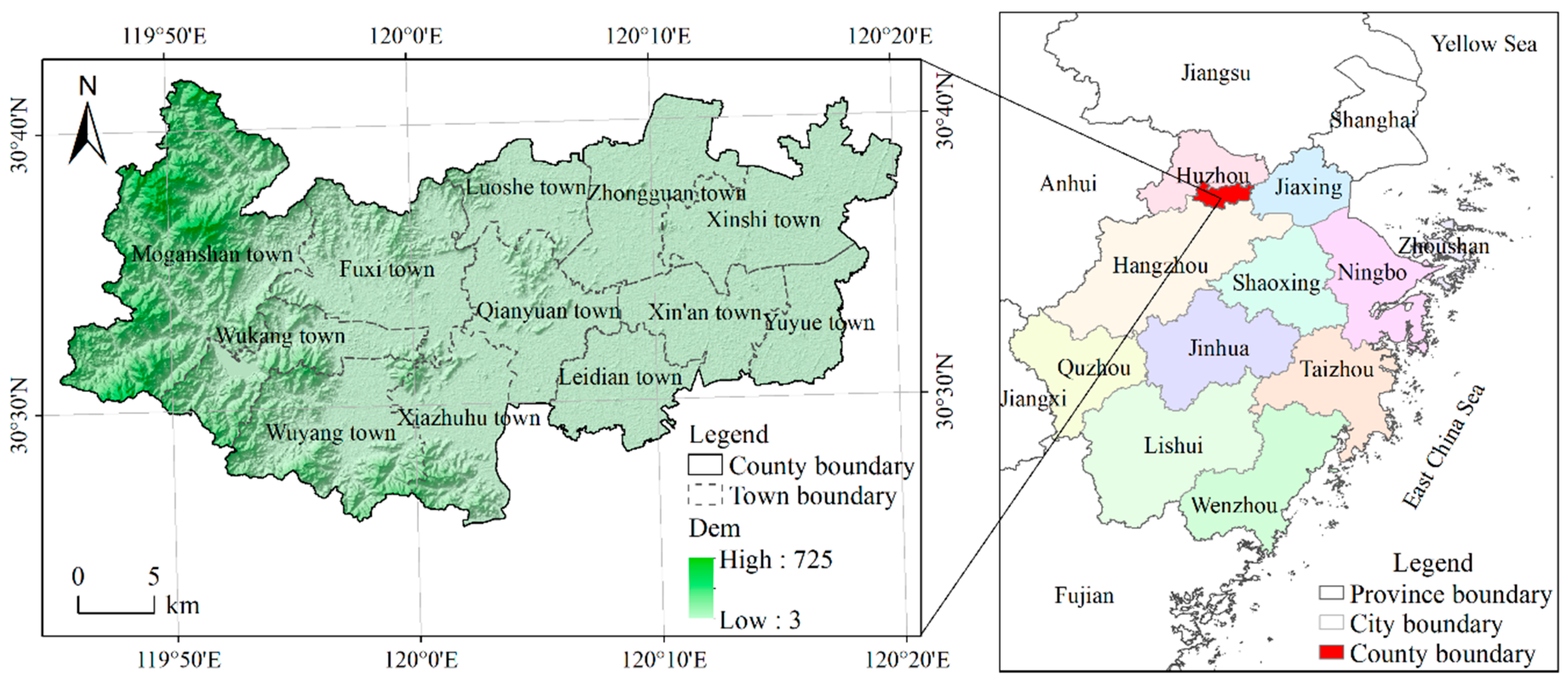
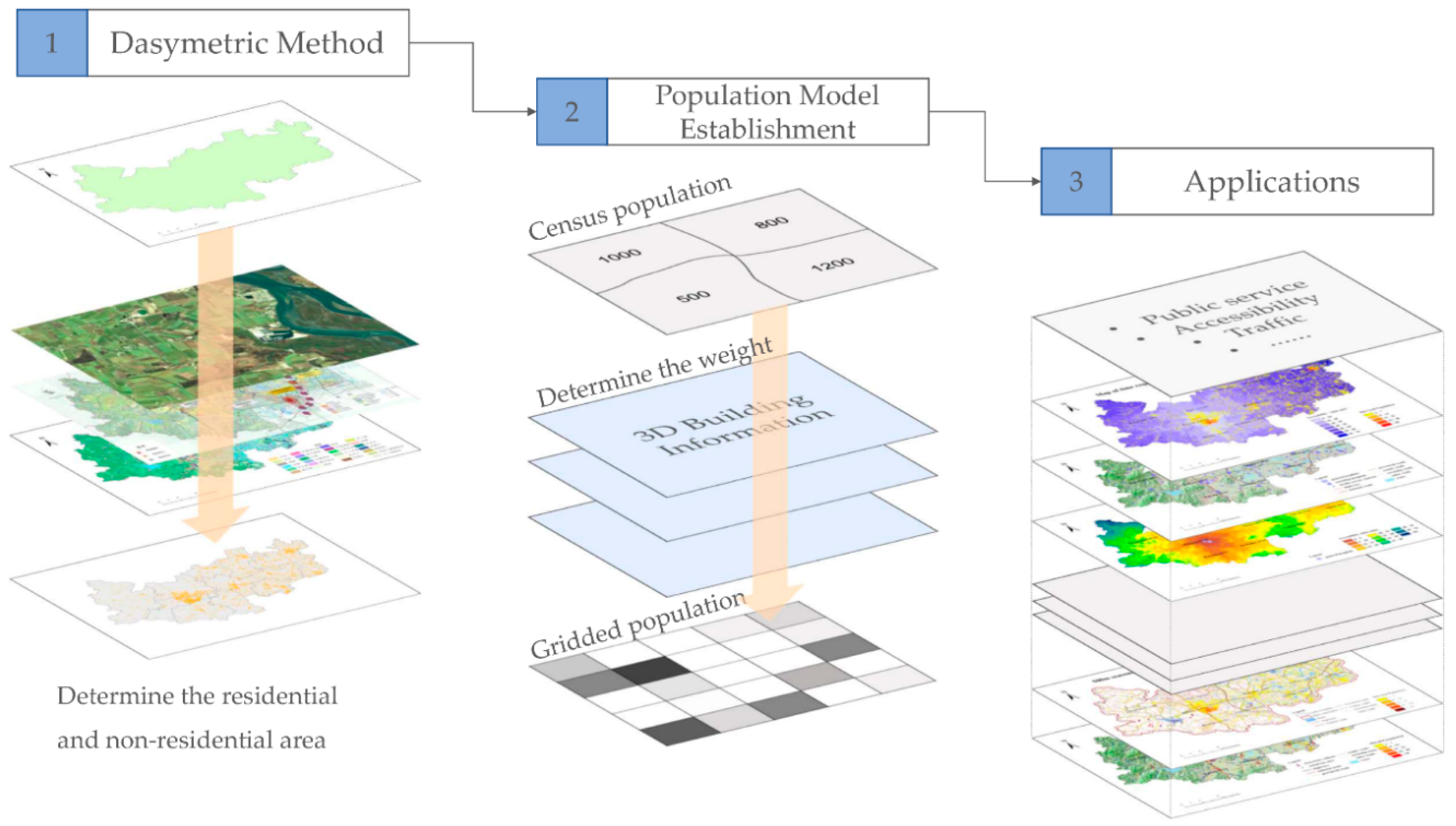
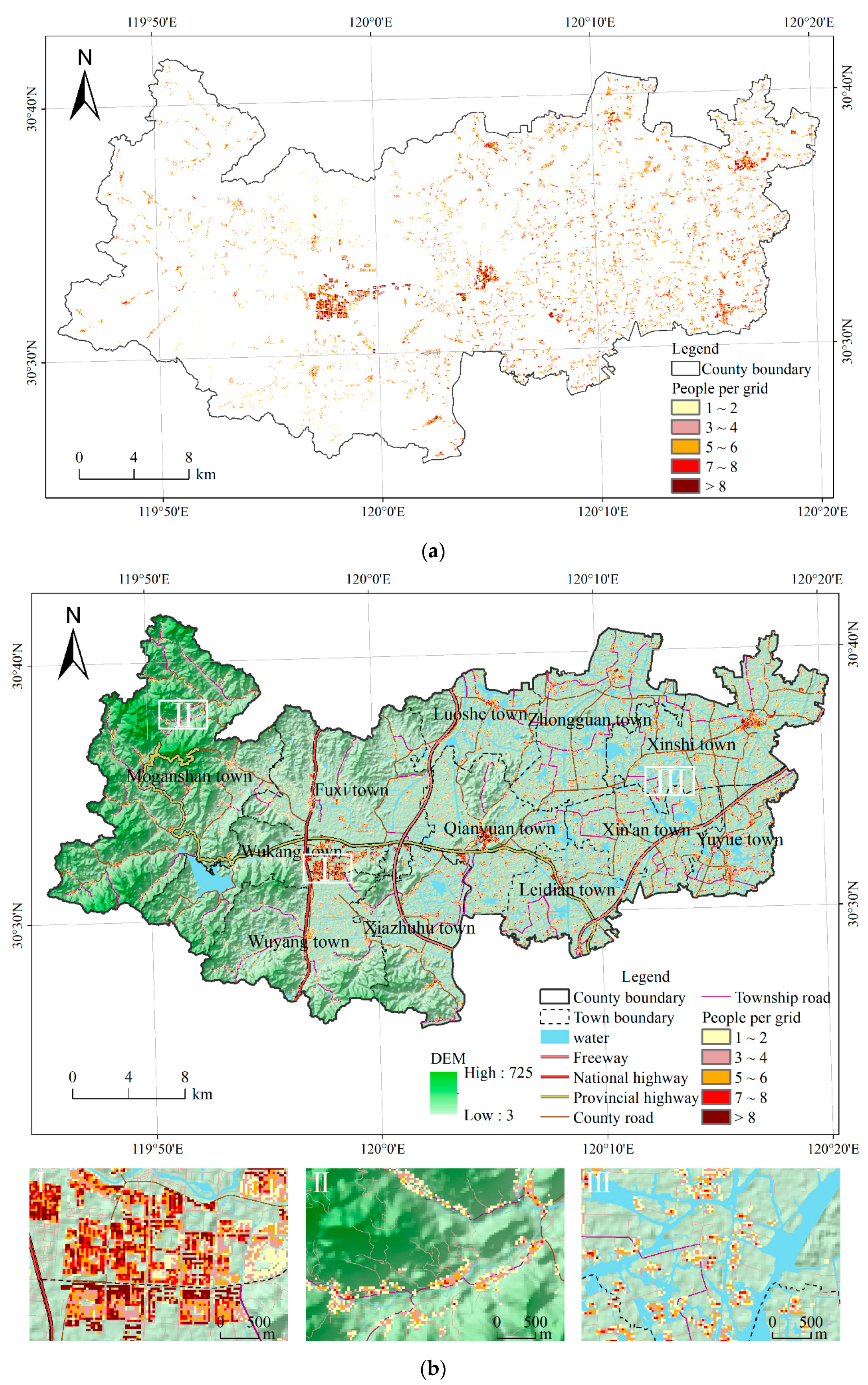
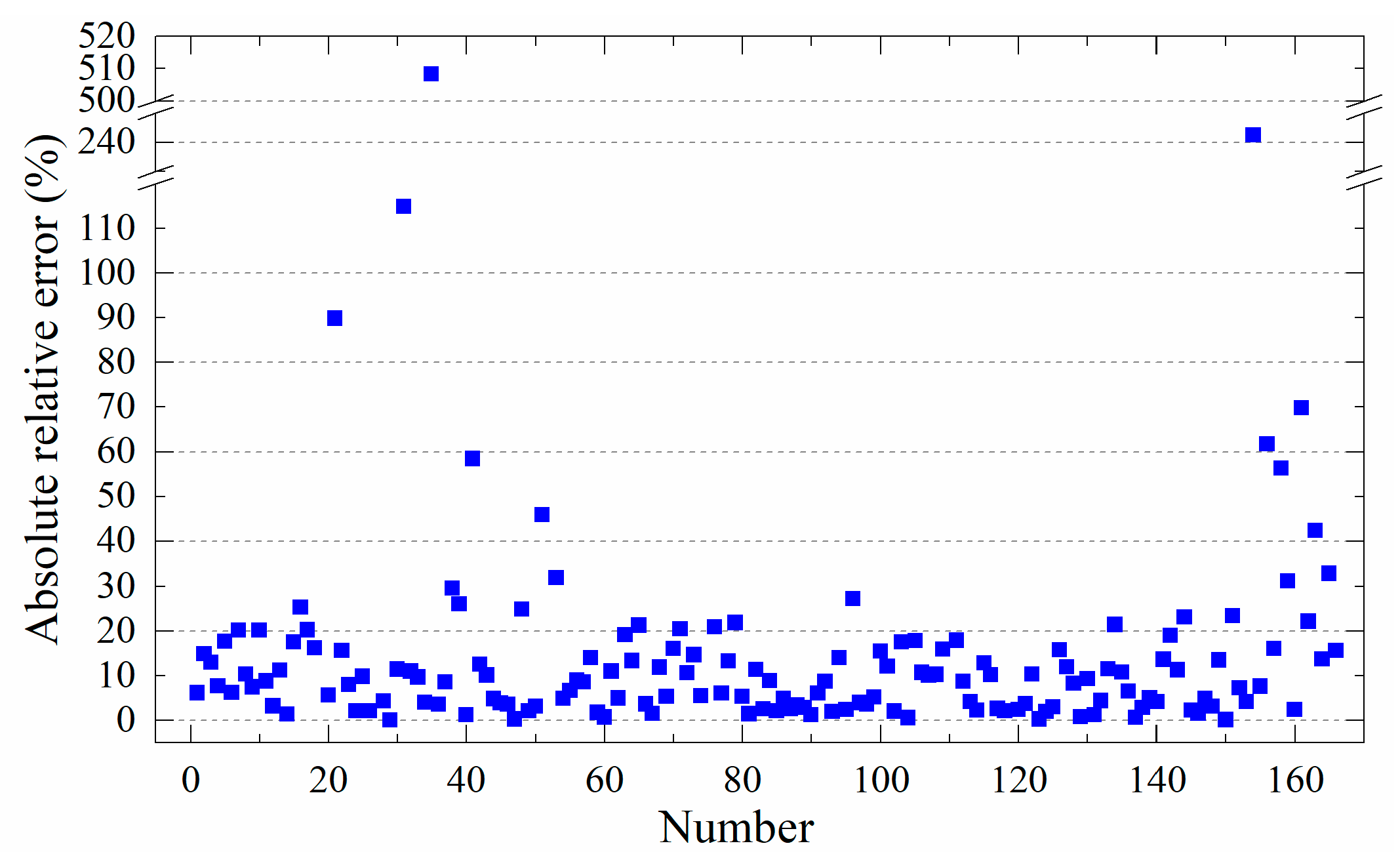
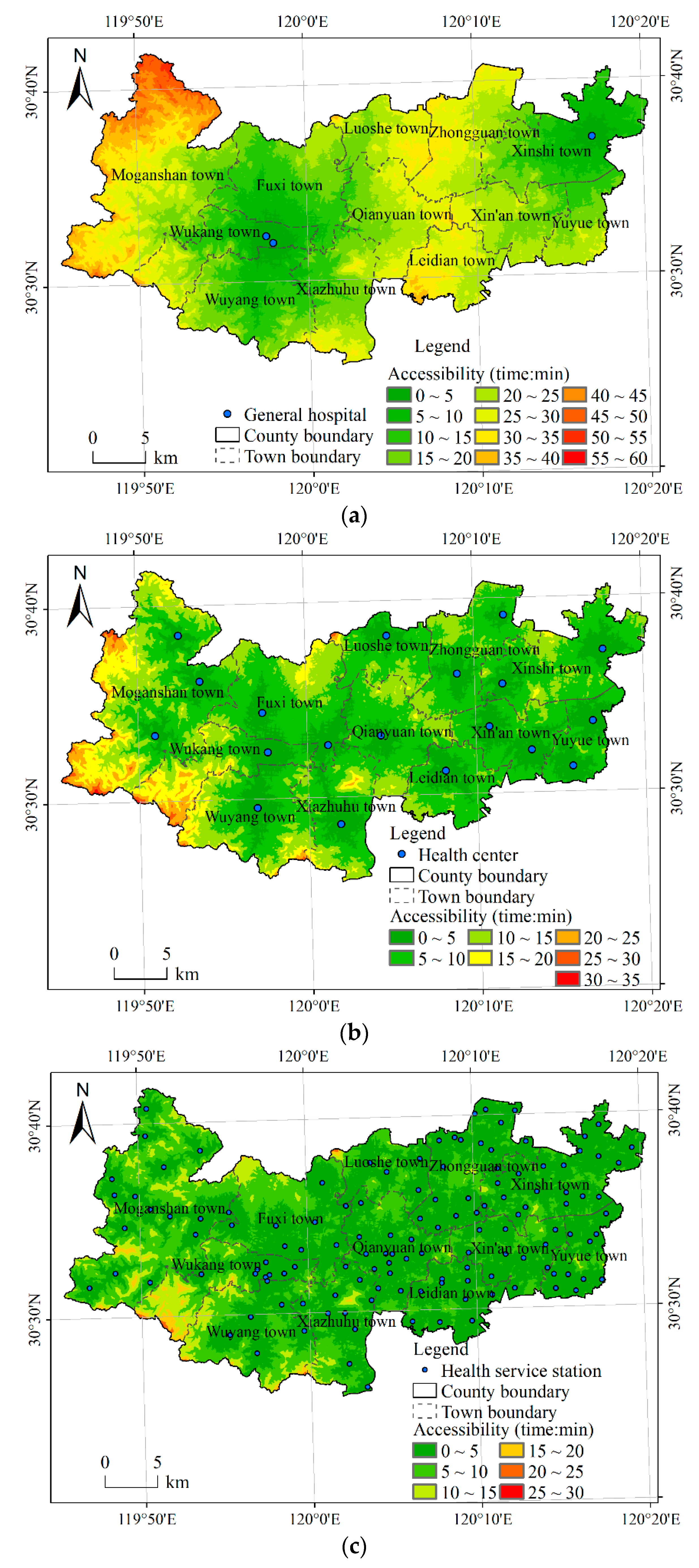
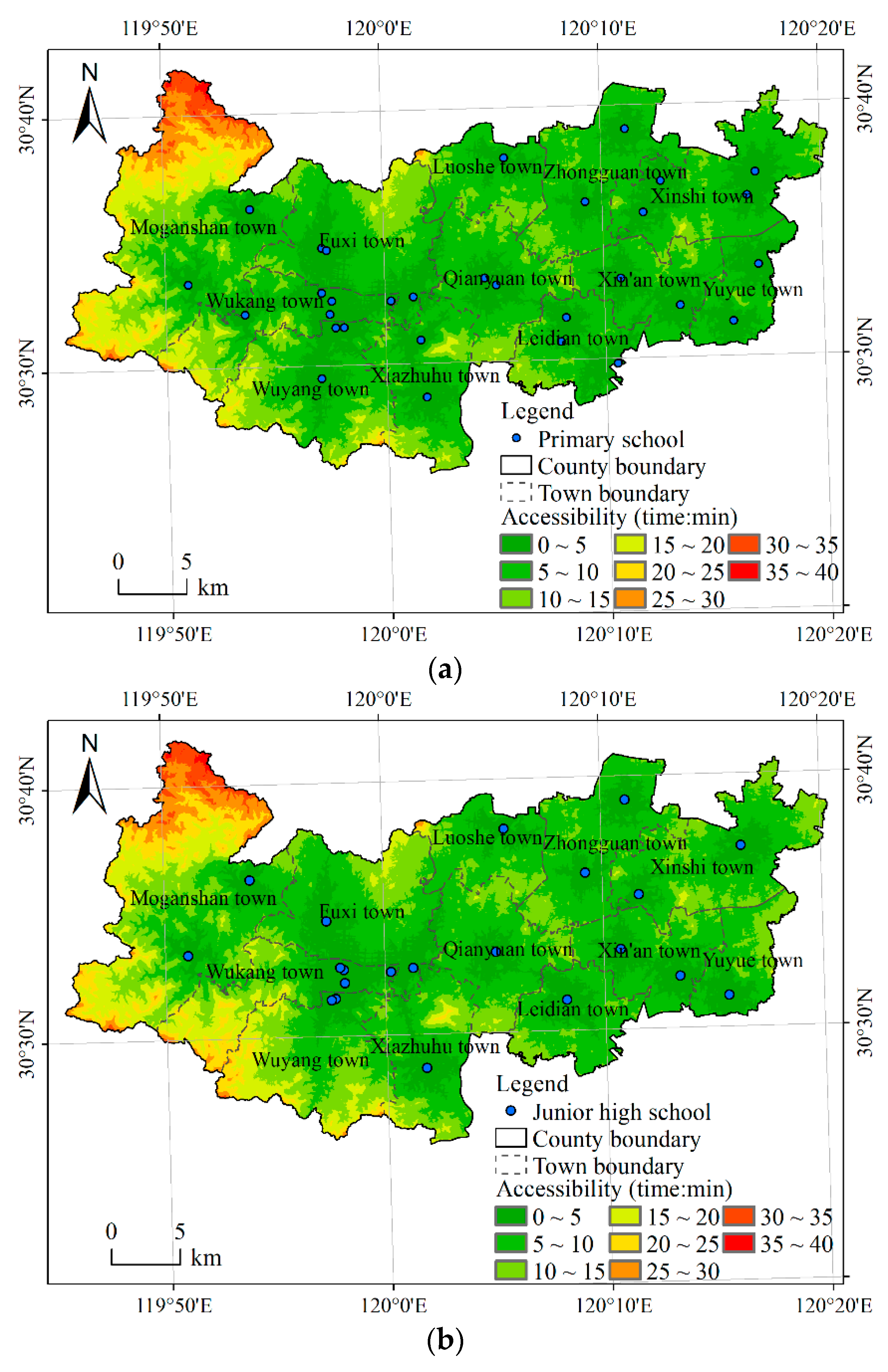
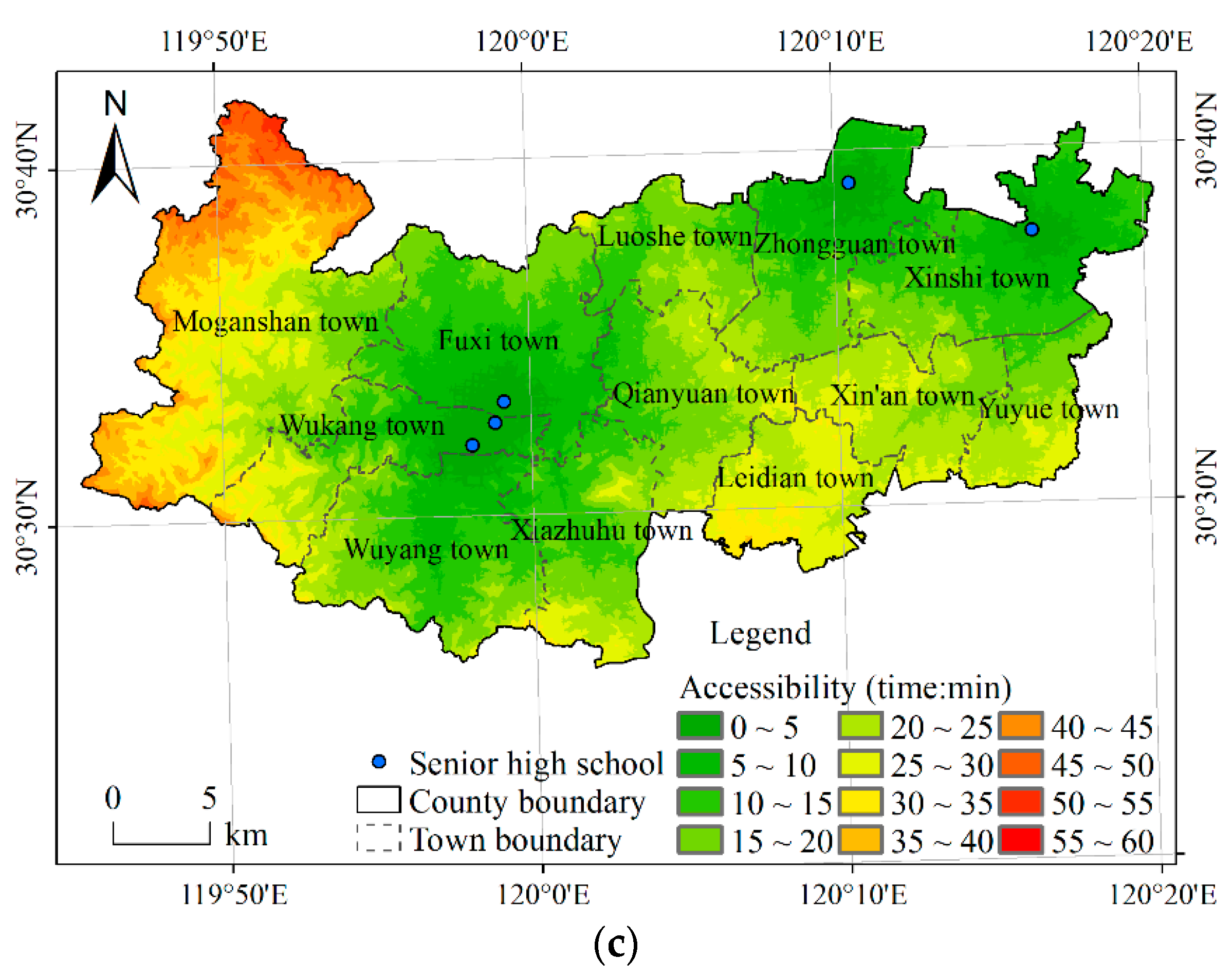
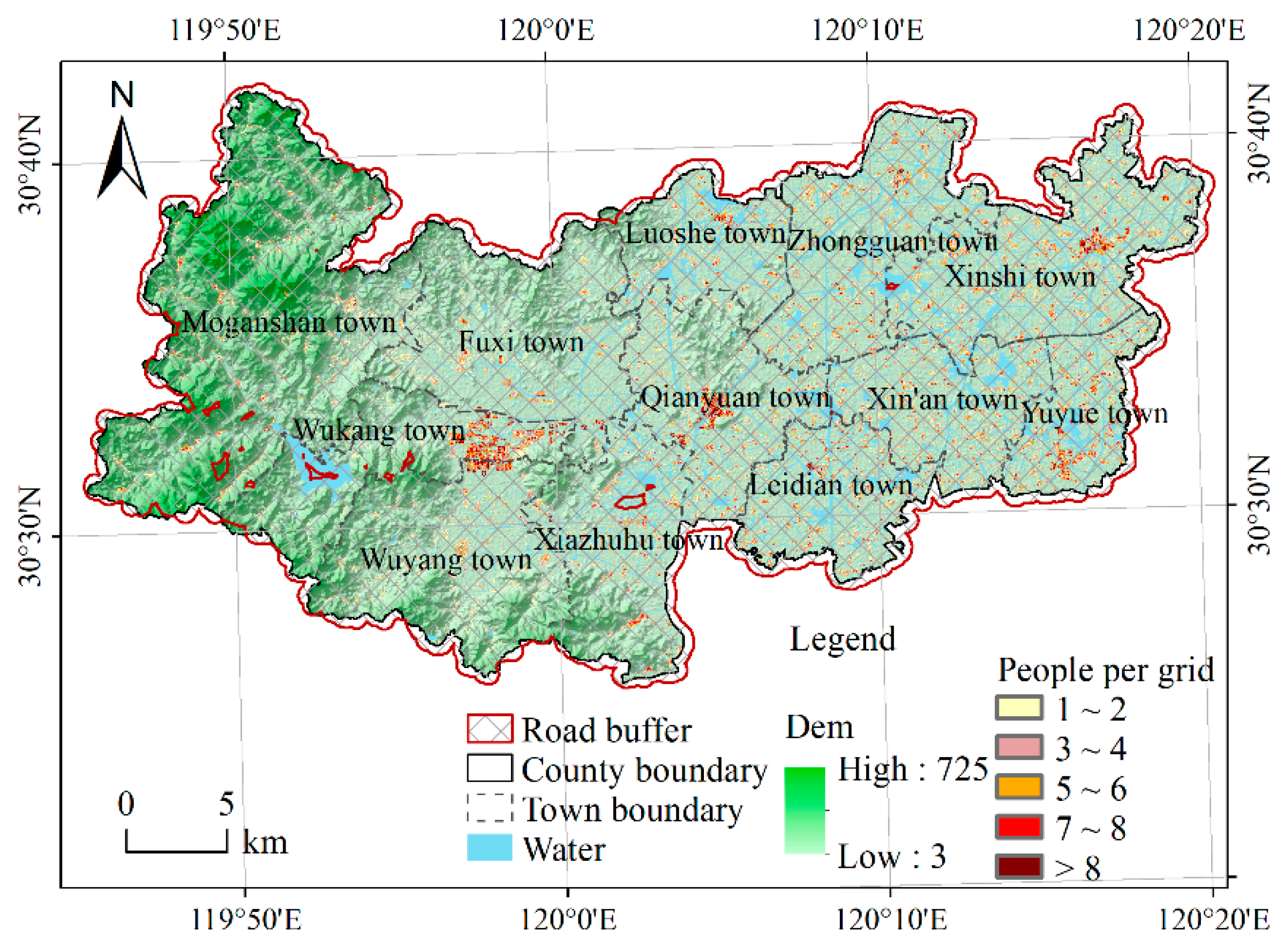
| Data | Format | Description | Source |
|---|---|---|---|
| Statistical population data | Table | Town and village level | Statistical Bureau of Deqing County |
| Three-dimensional building information | Polygon features | Including the building area and the number of floors | Geomatics Center of Deqing County |
| Aerial images | Raster | Resolution: 0.5 m; acquired time: October 2016; bands: red, green, blue | Geomatics Center of Deqing County |
| National geoinformation survey data | Vector layer (point, line, polygon features) | Including infrastructure location (e.g., medical and health and education facilities), boundaries, roads, buildings | Geomatics Center of Deqing County |
| Time (min) | Percentage (General Hospital) | Cumulative Percentage (General Hospital) | Percentage (Health Center) | Cumulative Percentage (Health Center) | Percentage (Health Service Station) | Cumulative Percentage (Health Service Station) |
|---|---|---|---|---|---|---|
| 0–5 | 3.52 | 3.52 | 23.32 | 23.32 | 67.02 | 67.02 |
| 5–10 | 9.84 | 13.37 | 49.42 | 72.74 | 25.90 | 92.92 |
| 10–15 | 15.39 | 28.76 | 19.34 | 92.07 | 5.75 | 98.67 |
| 15–20 | 20.37 | 49.12 | 5.66 | 97.73 | 1.17 | 99.85 |
| 20–25 | 23.34 | 72.46 | 1.90 | 99.63 | 0.14 | 99.99 |
| 25–30 | 18.14 | 90.61 | 0.33 | 99.97 | 0.01 | 100 |
| 30–35 | 6.23 | 96.84 | 0.03 | 100 | ||
| 35–40 | 1.67 | 98.51 | ||||
| 40–45 | 0.91 | 99.42 | ||||
| 45–50 | 0.50 | 99.92 | ||||
| 50–55 | 0.08 | 100 |
| Time (min) | Percentage (General Hospital) | Cumulative Percentage (General Hospital) | Percentage (Health Center) | Cumulative Percentage (Health Center) | Percentage (Health Service Station) | Cumulative Percentage (Health Service Station) |
|---|---|---|---|---|---|---|
| 0–5 | 14.21 | 14.21 | 46.16 | 46.16 | 92.64 | 92.64 |
| 5–10 | 12.45 | 26.66 | 44.10 | 90.26 | 7.20 | 99.84 |
| 10–15 | 12.25 | 38.91 | 8.68 | 98.94 | 0.15 | 99.99 |
| 15–20 | 17.36 | 56.27 | 0.96 | 99.90 | 0.01 | 100 |
| 20–25 | 19.84 | 76.10 | 0.10 | 100 | ||
| 25–30 | 17.06 | 93.16 | ||||
| 30–35 | 5.14 | 98.30 | ||||
| 35–40 | 1.04 | 99.34 | ||||
| 40–45 | 0.53 | 99.87 | ||||
| 45–50 | 0.13 | 100 |
| Time (min) | Percentage (Primary School) | Cumulative Percentage (Primary School) | Percentage (Junior High School) | Cumulative Percentage (Junior High School) | Percentage (Senior High School) | Cumulative Percentage (Senior High School) |
|---|---|---|---|---|---|---|
| 0–5 | 27.67 | 27.67 | 19.68 | 19.68 | 4.94 | 4.94 |
| 5–10 | 49.12 | 76.80 | 48.35 | 68.03 | 13.16 | 18.10 |
| 10–15 | 15.88 | 92.68 | 21.24 | 89.27 | 21.04 | 39.14 |
| 15–20 | 4.42 | 97.09 | 6.31 | 95.58 | 21.33 | 60.47 |
| 20–25 | 1.47 | 98.56 | 2.79 | 98.38 | 20.58 | 81.05 |
| 25–30 | 0.93 | 99.49 | 1.10 | 99.48 | 12.35 | 93.40 |
| 30–35 | 0.45 | 99.94 | 0.46 | 99.94 | 3.43 | 96.84 |
| 35–40 | 0.06 | 100 | 0.06 | 100 | 1.52 | 98.36 |
| 40–45 | 1.00 | 99.36 | ||||
| 45–50 | 0.54 | 99.91 | ||||
| 50–55 | 0.09 | 100 |
| Time (min) | Percentage (Primary School) | Cumulative Percentage (Primary School) | Percentage (Junior High School) | Cumulative Percentage (Junior High School) | Percentage (Senior High School) | Cumulative Percentage (Senior High School) |
|---|---|---|---|---|---|---|
| 0–5 | 51.32 | 51.32 | 42.48 | 42.48 | 18.20 | 18.20 |
| 5–10 | 39.47 | 90.80 | 43.23 | 85.72 | 13.63 | 31.82 |
| 10–15 | 6.43 | 97.23 | 10.88 | 96.59 | 18.44 | 50.26 |
| 15–20 | 1.62 | 98.86 | 2.24 | 98.83 | 19.66 | 69.92 |
| 20–25 | 0.51 | 99.37 | 0.54 | 99.37 | 13.57 | 83.49 |
| 25–30 | 0.53 | 99.90 | 0.53 | 99.90 | 11.49 | 94.97 |
| 30–35 | 0.10 | 100 | 0.10 | 100 | 3.11 | 98.08 |
| 35–40 | 1.22 | 99.30 | ||||
| 40–45 | 0.54 | 99.84 | ||||
| 45–50 | 0.16 | 100 |
© 2019 by the authors. Licensee MDPI, Basel, Switzerland. This article is an open access article distributed under the terms and conditions of the Creative Commons Attribution (CC BY) license (http://creativecommons.org/licenses/by/4.0/).
Share and Cite
Qiu, Y.; Zhao, X.; Fan, D.; Li, S. Geospatial Disaggregation of Population Data in Supporting SDG Assessments: A Case Study from Deqing County, China. ISPRS Int. J. Geo-Inf. 2019, 8, 356. https://doi.org/10.3390/ijgi8080356
Qiu Y, Zhao X, Fan D, Li S. Geospatial Disaggregation of Population Data in Supporting SDG Assessments: A Case Study from Deqing County, China. ISPRS International Journal of Geo-Information. 2019; 8(8):356. https://doi.org/10.3390/ijgi8080356
Chicago/Turabian StyleQiu, Yue, Xuesheng Zhao, Deqin Fan, and Songnian Li. 2019. "Geospatial Disaggregation of Population Data in Supporting SDG Assessments: A Case Study from Deqing County, China" ISPRS International Journal of Geo-Information 8, no. 8: 356. https://doi.org/10.3390/ijgi8080356
APA StyleQiu, Y., Zhao, X., Fan, D., & Li, S. (2019). Geospatial Disaggregation of Population Data in Supporting SDG Assessments: A Case Study from Deqing County, China. ISPRS International Journal of Geo-Information, 8(8), 356. https://doi.org/10.3390/ijgi8080356






